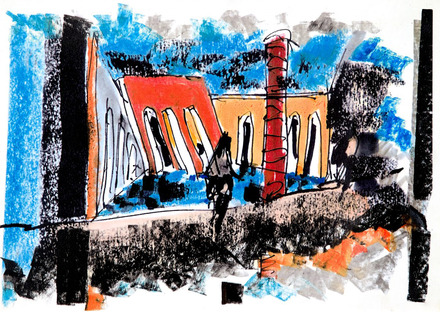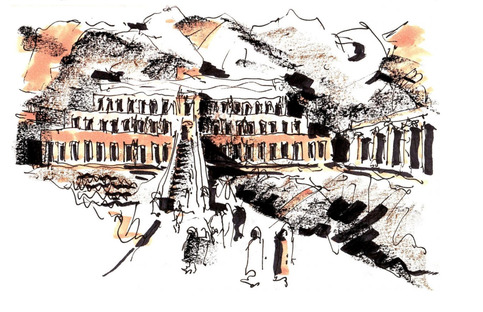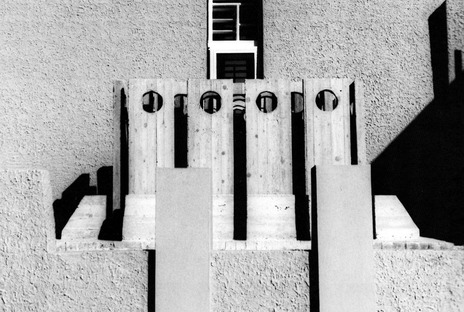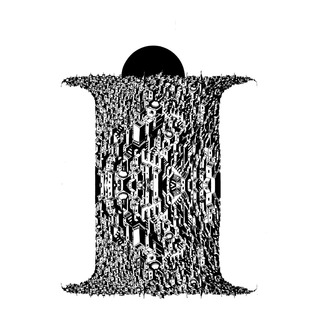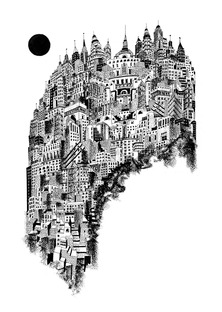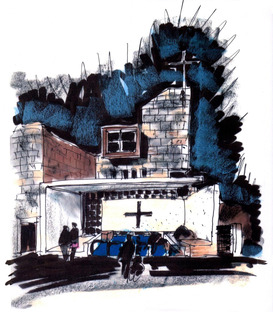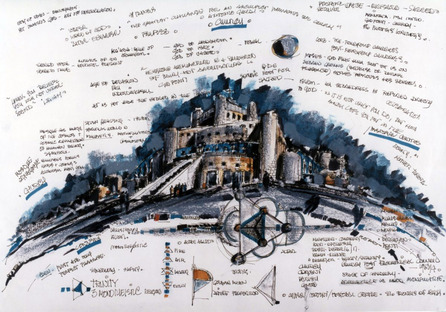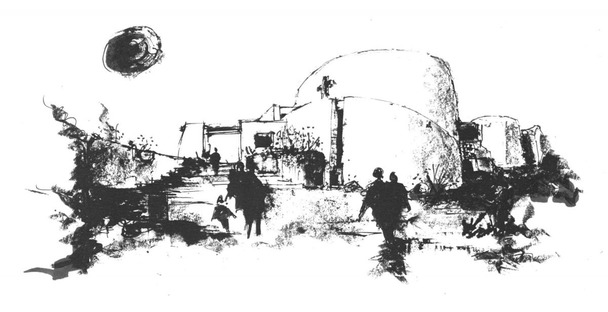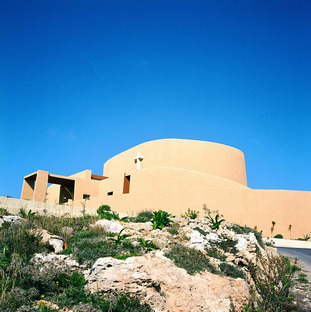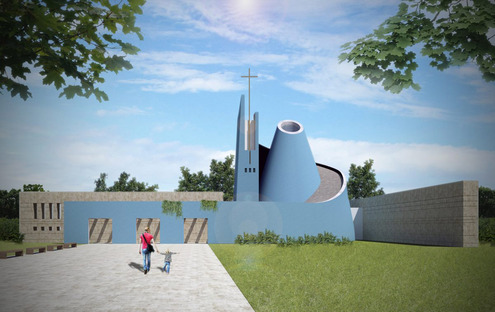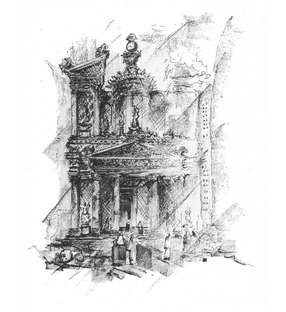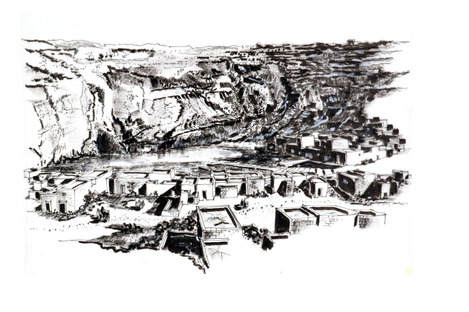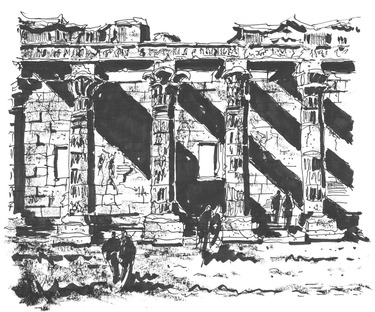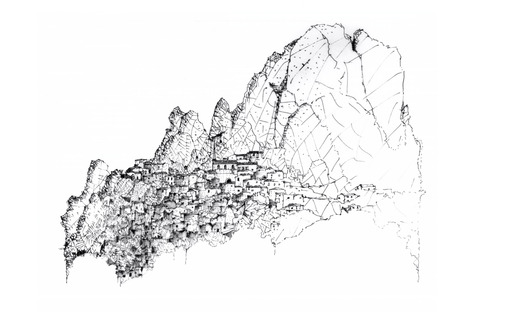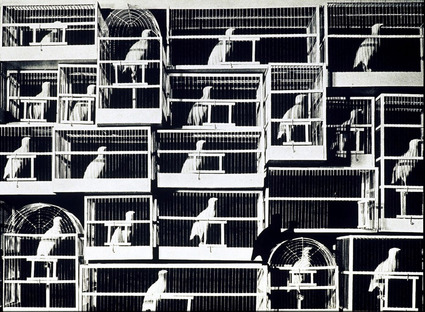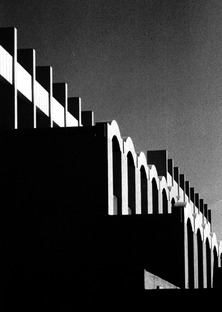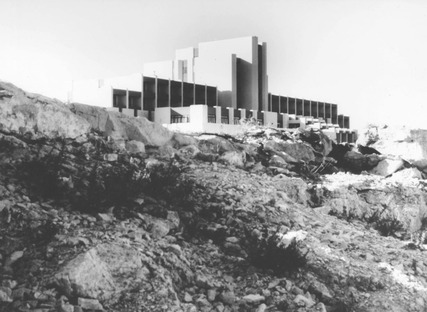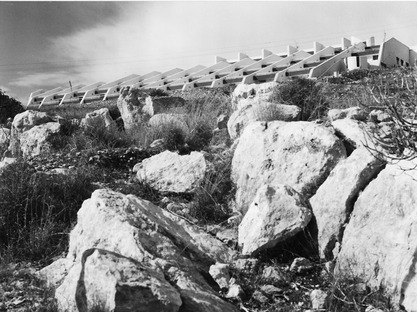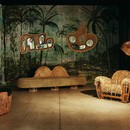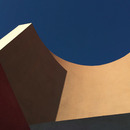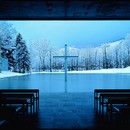21-10-2019
ONSTAGE: INTERVIEW WITH RICHARD ENGLAND Part 3
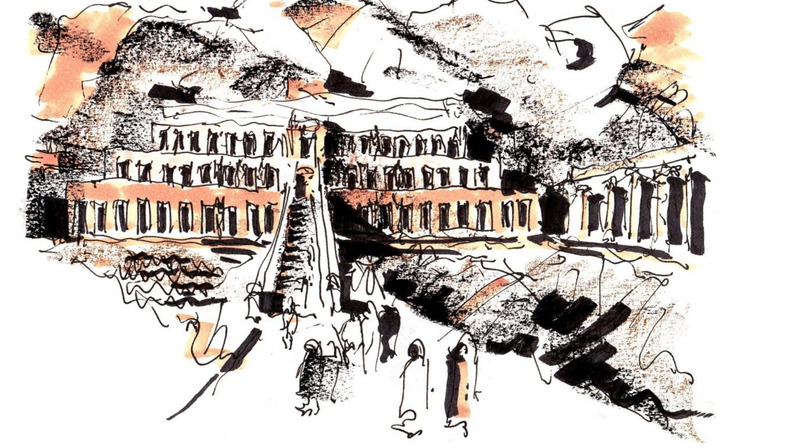 3. Sometimes, scrolling through the portfolio of certain architects, I would like to ask: "How is it possible?" There are so many works that I am unable to imagine moments of inspiration in silence. What do you think?
3. Sometimes, scrolling through the portfolio of certain architects, I would like to ask: "How is it possible?" There are so many works that I am unable to imagine moments of inspiration in silence. What do you think?
LOCI OF SILENCE
There are numerous places which I have visited where I experienced a fulfilling silence of communication. These loci manifest moments of emotive solace and allowed me instances of rhapsodic realms of meditative silence. I remain grateful to the authors (many lost in antiquity) of these spaces for allowing me to experience their dream-like creations.
HYPOGEUM - MALTA
A tenebrous series of underground chambers carved in the depths of the Maltese islands’ bed-rock. The Hypogeum was the burial ground for the dead of the Neolithic age. Its cavernous orbicular spaces provided a perfect ambience for ritualistic ceremonies related to the interment of the dead. An example of an architecture demonstrating an innate wisdom, now long lost in the annals of time. Einstein was right when he wrote that ”the ancients knew something which somehow we seem to have forgotten”.
DEIR EL BAHRI - EGYPT
Conceived as the paradisiac home for the female Pharaoh Hatshepsut in 1500BC and designed by architect Senenmut it remains one of the most extraordinary architectural complexes of ancient Egypt, harbouring an innovative architectural typology pre-empting later classical Greek buildings. Nestled into its background mountainous rock face it remains a truly imposing edifice. Viewing this ancient masterpiece one is prone to ask not what we have learnt but what we have since forgotten.
PETRA - JORDAN
Concealed in the moonscape terrain of the alien Wadi Rum is the Nabatean rock carved Rose City of Petra, one of history’s most magical manifestations of the fusion of the hand of man and the formations of nature. Emerging from the narrow, dark Siq gorge one views the sun drenched splendid façade of the Khazneh, a spine-tingling spectacle.
ASSISI - ITALY
In the monastic ambiences of Assisi one walks in the footsteps of Saint Francis. The Eremo delle Carceri nestled in the lush hills of Mount Subasio, is the paragon cave-like locus of silence and solace, where St Francis spent much of his time in meditation and prayer. It is a locus of perfect tranquillity, a remote isolated place to reflect on the life of the saint and contemplate on the mysteries of the Divine. The perfect antidote to our hectic modern life.
SAN GALGANO - ITALY
Located in the province of Siena in Tuscany the ashen skeletal ghost-like open to the sky gaunt shell remains of a 13th century Cistercian abbey provide an enchanting and soul enhancing atmosphere of spirituality and mystical silence. I was introduced to this splendid architectural carcass by the haunting images in Andrei Tarkovsky’s epic film 'Nostalgia'.
IRYOAN-JI GARDENS - JAPAN
The blueprint for a perfect garden. Conceived on the principals of Wabi-Sabi this 15th century enclave is the paramount example of Japanese Kara-Senzui dry gardens. Skeletal in composition it presents the perfect silent ascetic ambience. Termed the ‘Dragon of Peace’ this Zen Buddhist garden consists solely of fifteen rock boulders eloquently placed in a bed of polished river rocks. Minimalism at its best.
The tenebrous spectral remains of an abandoned village nestled into the Aspromonte mountains in the Southern Italian region of Calabria. Termed Italy’s “hand in the heel” because of its form, it has a history of family feuds, fights and murders. Walking the winding streets of this ruined place one can almost sense the presence of somnambulant ghosts. Time sheds memories, but stones retain them. It is a place tinged with dark overtones; a mournful grave-like ambience of mortuary silence.
ISLET OF FILFLA - MALTA
An outcast rock, south of the main island of Malta, a mystical islet born of the wedlock of moon and stars, a vagabond of the Middle Sea and an iceberg of stone. An arc of tranquillity cradled by lapping waters and sired by a burning sun. An altar of sacrality for the Neolithic civilisation which aligned its temples on to its cleft-shaped silhouette.
IL CRETTO - SICILY
Alberto Burri’s concrete mausoleum of poured concrete covering the ruins of the village of Gibellina destroyed by the devastating earthquake of 1968. A mummified corpse of a once thriving locus, a potent place of remembrance and recollection, a ‘memento mori’ mantled veil draped over the moribund remnants of the eradicated houses. One of the most powerful, contemplative and mournful examples of land art. A mnemonic blanket shroud draped over the village dwellings leaving the original pathways as passage ways. A strong evocation of place, memory and time.
TLALPAN CHAPEL - MEXICO - LUIS BARRAGAN
Rarely has so much been achieved by so little. An enclave of serenity best described as a building without adjectives. A minimalist edifice successfully fusing the canons of Modernism with Mexican tradition.
THERME VALS BATHS - SWITZERLAND - PETER ZUMTHOR
An exiguous cave-like structure buried in a hill, the interior of which is one where visitors may experience the building by all human senses; haptic, visual, aural, olfactory and oral; a real polyphony for the senses. An architecture to enrapture body, mind, spirit and soul.
JEWISH MUSEUM - BERLIN - DANIEL LIBESKIND
A disturbing, contorted bunker evoking memories of oppression and hate. The slashed inclined dashes which serve as openings rent the soul of the visitor. It is a veritable example of the power of architecture, an intense choreography of metaphor and memory. The building itself is so potent that it could have done without the exhibits. One leaves the museum mournful, downcast and doleful.
Contemporary silent spaces which I have not visited but which I also consider to be particularly potent include Tadao Ando’s Chapel of the Light in Japan, where light both diffuses and dissolves, the Spartan monastic austerity of John Pawson Novy Dvur Monastery in the Czech Republic and Aldo Rossi’s melancholic, nihilistic, Modena cemetery.
CONCLUSION
Architecture today, apart from the quoted examples and a few others, is rarely silent. It is loud and attention seeking as if to reflect the clamour of its egomaniac indulgent ‘star’ architects. “Too vain and distracted for silence, seeking, everyone after his own elevation”. T.S. Eliot. It was Luis Barragan who in his Pritzker prize acceptance speech lamented the absence in the pages of contemporary architectural publications of the words beauty, magic, enchantment, serenity and silence. In today’s deafening, ear-splitting dystopias the words of Japanese architect Takefumi Aida ring true “only silence can save architecture now”.
Living on an island has always coveted an irresistible lure as islands seem to resonate with legendary tales of magic and myth. Malta with its 5000 year old Neolithic temples and its neighbouring sister island of Gozo, Homer’s Ogygia, where Calypso detained Odysseus for seven years, are no exception. Myths and stories abound about the islet of Filfla, considered by some to be the last remnant of the lost continent of Atlantis. The sister island of Gozo houses under-water chapels, inland seas and tales of a golden calf treasure, besides harbouring the earliest example of free standing architecture, the Neolithic orbicular temple structure of Ggantija.
The main island of Malta is equally rich in legends and myths; the sink-hole of Maqluba in Qrendi, endless number of ghost stories, secret underground tunnels beneath the island’s capital city of Valletta, the Shipwreck of St Paul, the mysterious cave of Ghar Dalam, and the tale of the vanished children in the labyrinthine spaces of the lower chambers of the subterranean Necropolis of the Hypogeum.
Islands are characterised by their contrasting quality of isolation and connectivity. Malta is a solitary island and its location at the centre of the Mediterranean Sea has allowed it to absorb the influences of the powers and nations which have harboured an interest in the Middle Sea as if to manifest the contradictory isolation and connectivity equation, a complex and contrasting enigma of duality. Yet to me it is the mystical and mythical aspects of not only my native island but those of others, both real and imaginary which stimulate my curiosity and inspire my work.
Santorini or Thira, also one of the many assumed locations of the lost Atlantis is an island which so fascinated me with its stark contrast of lava black landscapes and superimposed cubic albescent white buildings that I penned a volume of text and drawings on this isle. The island was justly termed by Bernard Rudofsky as “the strangest place this side of heaven”. Malta’s own islet of Filfla has also haunted me for decades. In many of my poems I have utilised it as a source of inspiration. I even ventured to spend a night on this mystical rock to experience both its sounds and silences and spectral stillness, so extreme that at times I swear I could hear the moon waxing.
Mythological islands abound, from Plato’s Atlantis itself to the isle of Abaea, home of the goddess sorceress Circe, Avalon the island of Arthurian legend, Delos the birth place of Apollo and the ancient Greeks’ Isles of the Blessed, the passageway of the dead to Elysium, the resting place of the virtuous and heroic. All of these have inspired my prose, poems and drawings as have also the fantasies of imaginary lands and loci created by authors such as Calvino, Wells, More, Borges, Okri and Swift.
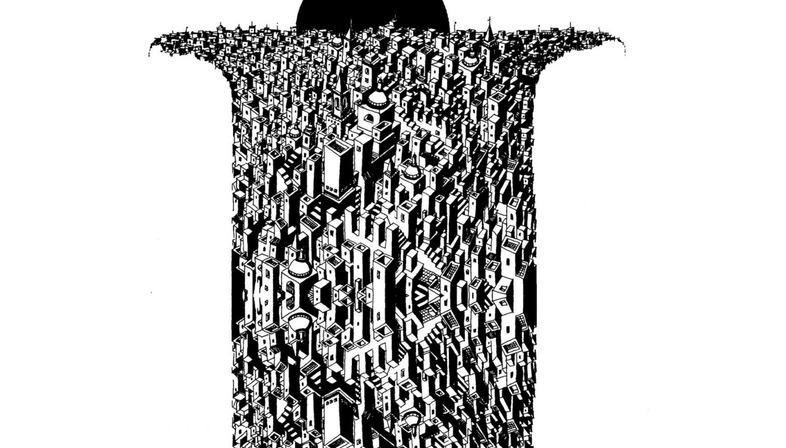
FRIENDS, ACQUAINTANCES & MENTORS
I consider myself fortunate to have met a number of illustrious architectural and art personalities, over the many years of my career. Each moment with these personalities turned out to be a veritable masterclass. They gave me their time and their wisdom; no greater gift can be given.
The following are the lessons I learnt:
From GIO PONTI I learnt to value and appreciate the Mediterranean and its vernacular typologies. Also to “design first and measure later”, and most of all to love architecture.
From CARLO SCARPA the lesson was how to combine the old with the new; how to intervene with history and bring old buildings back to life.
From GIANCARLO DE CARLO I assimilated the importance of the site, its voices and its mnemonic properties. His buildings in Urbino are a masterclass of how to relate architecture to place, memory and time.
From PIER LUIGI NERVI the lesson related to the poetics of structure and the innovative use of concrete.
BRUNO ZEVI thought me to love organic architecture and to admire and fully understand the architecture of Erich Mendelsohn.
From MASSIMILIANO FUKSAS one learns how one can be audacious, adventurous, bold, daring and inventive.
From RENZO PIANO I learnt to appreciate an architecture of good manners. His is always an architecture of lightness as if attempting to defy gravity.
FRANCO PURINI inspires me with his complex orthogonal drawings. Perhaps the Piranesi of today.
The lesson from PAOLO PORTOGHESI was a multi-cultural one due to his rich and astounding cultural baggage. Also of interest and influence were his studies and interests in the complex formations of nature.
From MARIO BOTTA, an extraordinary crafts man, I learnt from his architecture of sacrality, his early villas and most of all from his floating timber sculpture of the San Carlino, Francesco Borromini interior.
PAOLO SOLERI was an inspiration for his structures at Arcosanti and also for his complex intriguing Utopian drawings.
BASIL SPENCE provided a masterclass lesson in drawing and also in the process of how to ‘make’ a building. He was an architect who possessed a superb graphic elan and also incredible draftsmanship qualities, alas too rare today, as manual drawing has been over taken by CAD technology.
Meetings with DENNIS SHARP were always inspiring as he was a flowing font of architectural knowledge. His contribution to architectural literature remains an unsurpassable legacy.
From VICTOR PASMORE, who lived in Malta for thirty years I learnt about the dialectics of opposites and the importance of the elimination of the non-essential.
From QUENTIN HUGHES a pedagogue of remarkable intellectual and academic stature I learnt, at an early age, to understand and appreciate my native islands’ rich architectural heritage.
From RIFAT CHADIRJI I relearnt to respect Regionalism, the history and memories of place. Also, from his belief in an architecture which is technologically progressive but culturally conservative, in the sense that to conserve means to preserve and keep alive.
From HANS HOLLEIN, one of the few post-modern architects worth commending I learnt lessons from the elegance of his Retti candle and Schullin jewelry shops in Vienna and also from his dramatic Vulcania Museum in the Auvergne region of France.
From MANFREDI NICOLETTI I have a special admiration for his Astana Concert Hall, the ‘desert flower’ of Kazakhstan. It is a building of rare poetic beauty in the new Capital city littered with kitsch, vulgar upstart buildings.
From JUHANI PALLASMAA I absorbed the wisdom in the pages of his two seminal books ‘The Eyes of the Skin’ and ‘The Thinking Hand’, the former a lesson of how architecture is experienced by all of the human senses, the latter a hymn to the importance of drawing, confirming that even today the bridge between mind and paper is still best crossed by the hand.
I remain grateful to these great masters who I consider as personal mentors and pedagogues. Regrettably today, few star architects seem to have the time to discuss and establish rapports with young architects. A great loss for the youths and students.“The great teacher inspires”, William Arthur Ward.
6. Peter Zumthor in an interview said : “Great cities no longer exist because it is not urban planners who decide: skyscrapers go where the money is.” Do you also believe that things go in this direction?
ARCHITECTURE TODAY
“Today form follows profit” - Richard Rogers
Money making, profit and a passion for novelty have today taken over from an architecture of essence. Architecture has been downgraded to a profit making industry. Most of the Middle East developments bear witness to this, with their distorted, warped, drunk-looking edifices. It is regrettable that only a minute percentage of buildings erected today can in truth be termed architecture. Construction is now the norm. Architecture has become solely a money making mechanism. It has also regrettably become a commercial brand. Having a Hadid, Gehry of any other ‘star’ architect building is no different from having Armani, Dolce Gabbana or Prada clothing in the fashion industry.
7. Louis Kahn said to a collaborator: “You know, Gabor, if I could think what I would do, other than architecture, it would be to write the new fairy tale, because from the fairy tale came the airplane and the locomotive, and the wonderful instruments of our minds…all came from wonder". Kahn speaks of a fantasy that, unbridled, in fairy tales helps to inspire audacity of visions that cannot be conceived by rationality; you, instead, are an artist who makes the alchemy of dreams and the magic sphere an essential component of your work. Do you think that architecture and poetic fantasy can help each other?
Tales of magic, wonder, adventure and enchantment. Fairy tales bring back to adulthood the lost magic of childhood. The retention of the child within me remains a paramount requirement. It was Michael Ende who said “man dies when the last past of the child in him becomes an adult” and C.S. Lewis encouragingly stated “you are never too old to set another goal, or to dream a new dream”.
My own favourite tales include ‘The Emperor’s New Clothes’ and ‘The Little Mermaid’ by Hans Christian Andersen, Oscar Wilde’s ‘The Happy Prince’ and ‘The Nightingale and the Rose’, Norton Juster’s ‘the Phantom Tollbooth’, Ben Okri’s ‘Astonishing the Gods’ and above all Antoine de Saint Exupery’s ‘The Little Prince’. Two quotes from the latter were essential in the formation of my whole life’s philosophy: “It is useful because it is beautiful”: “It is only with the heart that one can see correctly, that which is essential is invisible to the eyes”. Other inspirational lesson quotes come from other tales: “My heart has wings and I can fly”, ‘Cinderella’: “If you dream a thing more than once, it is sure to come true”, ‘Sleeping Beauty’. Mermaids and unicorns, mythical creatures of fairy tales have also been featured in my poetry.











